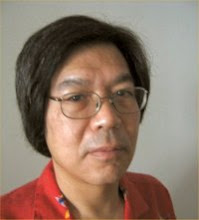Mixed doubles.
Yesterday, went to a press screening of the Australian "The Proposition"; as with a number of other films set in the days of Australia's colonization, it's a frightening portrait of "the wilderness" and the (un)civilizing effects of the "master race". From there, there was a reception at the Walter Reade Theater for David Noh's cousin Edgy Lee, a documentary filmmaker from Hawaii, but i had two hours in between, so i stayed midtown and went to a few galleries. At the Marlborough Gallery, paintings and drawings by Frank Auerbach. I didn't understand the work. Not because it was esoteric, but because Auerbach's work (very "expressionistic" with thick applications of paint so that the figurative nature of the image is obscured) isn't that different from the stuff usually shown at a lot of the coop galleries (Bowery, Blue Mountain, et al). At the Mary Boone Gallery, there was a show curated by Jose Friere: it was a "punk" show, with a lot of photos from the era of the mid-1980s, with shots of Richard Hell and the Voidoids, the Ramones, Television. The Edwynn Houk Gallery had photographs by Danny Lyons; the most interesting thing was the attempt, with a number of the photos, to arrange several (three, four, six) within a frame. But Lyons's photos are always very solid in terms of the type of b&w "art" photography of the 1960s, the era of Diane Arbus and Larry Clark, with photos of people on the wayside. At the McKee Gallery, a drawing show. A very solid show. Philip Guston's work seems to be very hot at the moment, but i was more impressed by some early Vija Celmins's drawings.
Then onto the Walter Reade, met Larry and we had a good time at the reception, where there were dancers doing a traditional hula; it was really a lot of fun. The documentary ("The Hawaiians: Reflecting Spirit") was a very traditional PBS-style doc about Hawaiian history, focussing on the rights of soverignty for the native Hawaiians. Can native traditions be preserved? It was interesting to see this documentary after "The Proposition", which shows an island nation (Australian) where there was a conscious attempt on the part of the whites to exterminate the native culture.
And now, of course, we have a president who thinks he has a god-given right to do the same thing: to eliminate the Muslim world, to annex the Middle East as a colony for the US. And (as if to defy any protests) he gives a press conference where he predicts that the US will "stay the course" for at least six more years.
Larry and i came home to see the final minutes of "American Idol"; checked Michael Giltz's blog to find out what i missed. But i think that Michael's suggestion that Ace might consider a career as a soap opera actor is rather facetious: it's actually very hard work, because the amount of memorization for a new script every day (especially if the character is popular) can be daunting. It's also nothing to sneeze at: at one point in the 1980s, the daytime Emmy Awards had (as nominees for "Best Supporting Actress") a line-up that included Eileen Herlie (Gertrude to Olivier's Hamlet in the 1949 film), Uta Hagen, Judith Anderson, and Kathleen Widdoes. When Julie Harris was (finally) signed as a regular on "Knot's Landing", she wound up making more money than she ever had in her entire career in the theater! (Of course, that was a nighttime soap, but still....) In the latest issue of Details, there's an article about actors in daytime, and how it's a steady job, which is rare in the acting profession. But every year, on or off Broadway, there's always some production with someone like Larry Bryggman or Benjamin Hendricksen, and they always get raves, and they're doing this show in between their steady soap opera jobs. Which reminds me: the last issues of Details and Interview had fashion spreads by Collier Schorr, Jack Pierson, and... one of the McDermott and McGough boys. This is what's happened to our culture. In the 1950s, people who worked in areas like window dressing (Jasper Johns, Rauschenberg) or advertising (Lichtenstein, Andy Warhol) aspired to "the fine arts", to become an "artist" and not simply a commercial craftsman. Now, it's the reverse: you're an artist in a gallery, and then you get to do ads and fashion spreads. That's what's happened to our culture.


0 Comments:
Post a Comment
<< Home